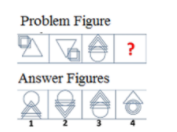Refer to the data below and answer the question that follow-
A national level competition held last year, participants were free to choose their respective areas from which they were asked questions. Out of 880 participants, 224 choose philosophy, 240 choose science and 336 choose sports, 64 choose both science and sports, 80 choose philosophy and sports, 40 choose, philosophy and science and 24 choose all the three areas.
The percentage of participants who did not choose any area is
0.2359
0.3025
0.3746
0.2727
To solve the problem step by step, we will use the principle of inclusion-exclusion to find the number of participants who did not choose any area.
Step 1: Define the sets
Let:
- P = number of participants who chose Philosophy = 224
- S = number of participants who chose Science = 240
- T = number of participants who chose Sports = 336
- PS = number of participants who chose both Philosophy and Science = 40
- PT = number of participants who chose both Philosophy and Sports = 80
- ST = number of participants who chose both Science and Sports = 64
- PST = number of participants who chose all three areas = 24
Step 2: Apply the Inclusion-Exclusion Principle
The total number of participants who chose at least one area can be calculated using the formula:
|P∪S∪T|=|P|+|S|+|T|−|PS|−|PT|−|ST|+|PST|
Substituting the values:
|P∪S∪T|=224+240+336−40−80−64+24
Step 3: Calculate the total
Now, we perform the calculations:
|P∪S∪T|=224+240+336−40−80−64+24
=800−184+24
=800−160
=640
Step 4: Find the number of participants who did not choose any area
The total number of participants is given as 880. Therefore, the number of participants who did not choose any area is:
Participants not choosing any area=880−|P∪S∪T|
=880−640=240
Step 5: Calculate the percentage of participants who did not choose any area
To find the percentage of participants who did not choose any area, we use the formula:
Percentage=(Number of participants not choosing any areaTotal participants)×100
=(240880)×100
Step 6: Simplify the percentage calculation
=(240÷80880÷80)×100
=(311)×100
=30011≈27.27%
Final Answer
The percentage of participants who did not choose any area is approximately 27.27%.
---
Let:
- P = number of participants who chose Philosophy = 224
- S = number of participants who chose Science = 240
- T = number of participants who chose Sports = 336
- PS = number of participants who chose both Philosophy and Science = 40
- PT = number of participants who chose both Philosophy and Sports = 80
- ST = number of participants who chose both Science and Sports = 64
- PST = number of participants who chose all three areas = 24
The total number of participants who chose at least one area can be calculated using the formula:
|P∪S∪T|=|P|+|S|+|T|−|PS|−|PT|−|ST|+|PST|
|P∪S∪T|=224+240+336−40−80−64+24
Now, we perform the calculations:
|P∪S∪T|=224+240+336−40−80−64+24
=800−184+24
=800−160
=640
The total number of participants is given as 880. Therefore, the number of participants who did not choose any area is:
Participants not choosing any area=880−|P∪S∪T|
=880−640=240
To find the percentage of participants who did not choose any area, we use the formula:
Percentage=(Number of participants not choosing any areaTotal participants)×100
=(240880)×100
=(240÷80880÷80)×100
=(311)×100
=30011≈27.27%
The percentage of participants who did not choose any area is approximately 27.27%.
Similar Questions
Knowledge Check
Choose the correct answer from the following.
AAn area of one square centimeter is 10 times greater than one square meter.B1 hour 18 min is equal to 3618 secondsCSl unit of density is cubic metres.DMetre is the standard unit to measure length.Choose the correct form of adverb for the given sentence :
They were …..questioned.ARepeatedlyBrestrictivelyCreportedlyDrepantantlyChoose the odd numeral pair in each of the following questions :
A81-63B24-48C21-15D13-39
Why was science called natural philosophy in earlier days?
View SolutionChoose the odd numeral pair in each of the following questions :
View SolutionChoose the odd numeral pair in each of the following questions :
View SolutionChoose the odd numeral pair in each of the following questions :
View SolutionChoose the odd numeral pair in each of the following questions :
View Solution


